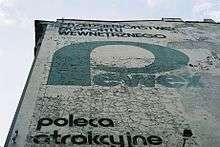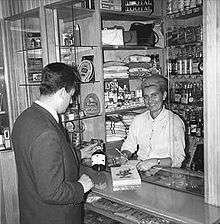Pewex
Pewex (Polish pronunciation: [ˈpɛvɛks]) (short for Przedsiębiorstwo Eksportu Wewnętrznego – Internal Export Company[1]) was a chain of shops founded in 1972, during the Communist era in Poland that accepted payment only in United States dollars and other hard currencies, instead of the country's indigenous currency, the Złoty.[2]
 A mural in Łódź depicting the company logo | |
 A Pewex shop | |
Native name | Przedsiębiorstwo Eksportu Wewnętrznego |
|---|---|
| State-owned enterprise | |
| Industry | General stores |
| Founded | 1972 |
| Founder | Government of the Polish People's Republic |
| Revenue | 20 billion złoty (1987) |
| Owner | Pekao (1972–1991) Marian Zacharski (1991–?) |
History
Pewex was created in the 1970s to help combat Communist Poland's foreign currency deficit.[1]
By the late 1960s, it had become apparent that the then socialist centrally-planned economy of Poland was inefficient. The rule of Edward Gierek led to a short period of economic prosperity. With the aid of foreign loans, Gierek instituted a programme to modernise industry and increase the availability of consumer goods. The standard of living increased markedly and for a time he was hailed a miracle-worker. The economy, however, began to falter during the 1973 oil crisis and by 1976 price increases became necessary, mostly to ease the repayment of these loans.

To obtain much needed foreign currency from Polish society, authorities permitted in 1972 the creation of a network of shops under a state-owned bank named Pekao. There, the foreign hard currency could be exchanged for both foreign and domestic goods, many of which were unavailable to Poles at that time. Since ownership of hard currency as cash was forbidden and all dollars and Deutschmarks had to be deposited to dollar bank accounts, authorities introduced Bon PeKaO cheques, which were tied to the U.S. Dollar in a 1:1 ratio and could be used as currency in Pekao shops. Later on the Pekao bank created a separate company, Przedsiębiorstwo Eksportu Wewnętrznego – the Pewex. While the letter x is not present in the Polish alphabet, it was used nevertheless.
During the Communist era, Poles were allowed to own Dollars, something that was not allowed in other Eastern Bloc states. Many Poles at the time also received remittance from friends and family members in the United States.[3] The US Dollars received by Poles could either be used for foreign travel or used at the Pewex shops.[3] Products that Poles would otherwise have to wait a long time and settle for poor imitations of could be had immediately by buying them at a Pewex shop.[4]
Pewex offered a number of items not available for purchase on the normal market. Items were purchased outside of the rationing system then in place, and customers did not have to queue up for items.[5] Items sold include liquor, cigarettes, household appliances, cars and furniture.[5]
Shopping at Pewex at the time was seen as a rather exclusive affair, due to the high cost of its items when compared to the average salary at the time.[5] This turned Pewex into a symbol of luxury and privilege.[5]
At one point, Pewex had a network of 80 shops in Poland.[6] In 1987, Pewex was noted in a report issued by the United States Joint Publications Research Service to have had a sales volume of about 70 billion złoty, based on the then-official exchange rate to the US Dollar, with a revenue of 20 billion złoty.[7]
Post-Communist government
As part of the peaceful transition of the economic system in Poland after 1989's revolution in Poland, the Polish economy was privatised and the ownership of foreign currency was deregulated. This made the Pekao cheques obsolete and soon afterwards most of the goods that had only been available from Pewex stores started to be sold in private shops as well.
In 1991, Marian Zacharski, a former Polish spy who was sentenced to life in prison by American authorities for stealing military secrets and was subsequently released in a spy exchange, became the chain's chief.[8]
In 1993, Pewex filed for bankruptcy for the first time.[9] In December 1995, it was announced that a debt restructuring deal would see the a bank named Polski Bank Rozwoju, along with two French companies, swap a debt worth 93.6 million złoty at the time for a majority stake in 1996.[10]
See also
- Baltona
- Shortage economy
- Eastern Bloc economies
Further reading
- Zlot a lot of dollars. (Pewex stores in Poland), The Economist, May 1988
References
- Oleksiak, Wojciech (23 March 2015). "10 Mind-Boggling Oddities of Communist Poland". culture.pl. Retrieved 19 June 2019.
- Diehl, Jackson (21 December 1986). "Poland's Dollar Stores Busy". The Washington Post. Retrieved 19 June 2019.
- Yuenger, James (26 November 1986). "Say, how much is that in vodka?". Chicago Tribune. Retrieved 19 June 2019.
- Lewis, Paul (9 October 1981). "The Lure of a Dollar in Poland". The New York Times. Retrieved 19 June 2019.
- Brzyska, Anna. "Coupons and dollar vouchers... or the means of payment in the Polish People's Republic" (PDF). National Bank of Poland. p. 12. Retrieved 30 September 2019.
- Sels, A.T.H. (2006). "Foreign direct investment as an entry mode. An application in emerging economies" (PDF). Tilburg University. p. 182. Retrieved 30 September 2019.
- "JPRS Report: Eastern Europe" (PDF). Foreign Broadcast Information Service. 17 February 1988. pp. 30–31. Retrieved 30 September 2019.
- Engleberg, Stephen (27 January 1991). "Polish spy trades cloak and dagger for cash register". Chicago Tribune. New York Times News Service. Retrieved 30 September 2019.
- Cienski, Jan (2018). Start-Up Poland: The People Who Transformed an Economy. University of Chicago Press. p. 131. ISBN 9780226306810. Retrieved 30 September 2019.
- "Creditors to takeover retail chain" (PDF). New Europe (133). 10–16 December 1995. p. 17. Retrieved 30 September 2019.
External links
- (in Polish) Atlantyda Ludowa, czyli jak zmarnowano najlepszą markę PRL-u
- Ewa Cander-Karolewska, Painted advertisement for Pewex, 1 August 2007,